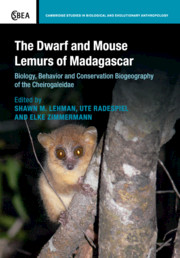 The Dwarf and Mouse Lemurs of Madagascar
The Dwarf and Mouse Lemurs of Madagascar Book contents
- Frontmatter
- Contents
- List of contributors
- Foreword
- Part I Cheirogaleidae: evolution, taxonomy, and genetics
- Part II Methods for studying captive and wild cheirogaleids
- Part III Cheirogaleidae: behavior and ecology
- 12 Morphology, behaviour, ranging patterns and habitat use of the northern giant mouse lemur Mirza zaza in Sahamalaza, northwestern Madagascar
- 13 Living in riverine and xeric forests: Microcebus griseorufus at Beza Mahafaly, southwestern Madagascar
- 14 Determinants of isotopic variation in two sympatric mouse lemur species from northwestern Madagascar
- 15 Your food, my food: patterns of resource use in two sympatric mouse lemur species
- 16 The physiology of phyletic dwarfi sm in Cheirogaleidae
- 17 Possible causes and consequences of different hibernation patterns in Cheirogaleus species – Mitovy fatsy sahala
- Part IV Cheirogaleidae: sensory ecology, communication, and cognition
- Part V Cheirogaleidae: conservation biogeography
- Index
- Plate section
- References
12 - Morphology, behaviour, ranging patterns and habitat use of the northern giant mouse lemur Mirza zaza in Sahamalaza, northwestern Madagascar
from Part III - Cheirogaleidae: behavior and ecology
Published online by Cambridge University Press: 05 March 2016
- Frontmatter
- Contents
- List of contributors
- Foreword
- Part I Cheirogaleidae: evolution, taxonomy, and genetics
- Part II Methods for studying captive and wild cheirogaleids
- Part III Cheirogaleidae: behavior and ecology
- 12 Morphology, behaviour, ranging patterns and habitat use of the northern giant mouse lemur Mirza zaza in Sahamalaza, northwestern Madagascar
- 13 Living in riverine and xeric forests: Microcebus griseorufus at Beza Mahafaly, southwestern Madagascar
- 14 Determinants of isotopic variation in two sympatric mouse lemur species from northwestern Madagascar
- 15 Your food, my food: patterns of resource use in two sympatric mouse lemur species
- 16 The physiology of phyletic dwarfi sm in Cheirogaleidae
- 17 Possible causes and consequences of different hibernation patterns in Cheirogaleus species – Mitovy fatsy sahala
- Part IV Cheirogaleidae: sensory ecology, communication, and cognition
- Part V Cheirogaleidae: conservation biogeography
- Index
- Plate section
- References
Summary
Introduction
Madagascar is one of the most important biodiversity hotspots in the world, underpinned by its high proportion of endemic species and high rates of deforestation of about 1500 km2 per year (Myers et al., 2000; Moat and Smith, 2007). Since 1997 until today, the number of described lemur taxa has risen from 50 to 107 species and subspecies (Schwitzer et al., 2013). In 2012, a new IUCN Red List assessment revealed that 94% of the then 103 described lemur taxa had been placed in one of the Threatened categories (Schwitzer et al., 2013). Apart from geographic distribution and population densities, thorough knowledge of the biology and ecology, such as habitat needs or life-history data, are crucial to design conservation measures (Schwab and Ganzhorn, 2004; Merker et al., 2005; Schwitzer et al., 2013). In particular, the behaviour and ecology of nocturnal lemur species are poorly studied (Chapter 19); up until the reassessment in 2012, 37 of the 40 lemur taxa assessed as Data Deficient on the IUCN Red List were nocturnal (Schwitzer et al., 2013).
One of these poorly studied species is the nocturnal northern giant mouse lemur Mirza zaza Kappeler & Roos, family Cheirogaleidae, which was distinguished from M. coquereli Grandidier as a unique species in 2005 (Kappeler et al., 2005). M. zaza is a nocturnal lemur of approximately 300 g that lives in the dry deciduous forests of northwestern Madagascar up to the transition zone to the Sambirano evergreen rainforest domain in the north (Kappeler et al., 2005; Markolf et al., 2008). The species is IUCN Red-Listed as Endangered (IUCN, 2014). The only population estimates so far yielded the highest encounter rates in degraded forests with a high number of mango trees (Mangifera indica, family Anacardiaceae), the fruits of which may be an important food source for M. zaza (Markolf et al., 2008; Mittermeier, pers. comm.). Western dry forest is one of the forest types declining the most quickly in Madagascar, with ongoing threats to remaining and already heavily fragmented forests where M. zaza occurs (Schwitzer and Lork, 2004; Schwitzer et al., 2007).
- Type
- Chapter
- Information
- The Dwarf and Mouse Lemurs of MadagascarBiology, Behavior and Conservation Biogeography of the Cheirogaleidae, pp. 235 - 254Publisher: Cambridge University PressPrint publication year: 2016
References
- 9
- Cited by
